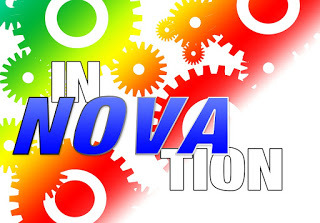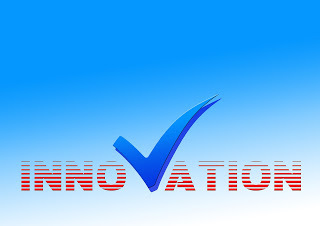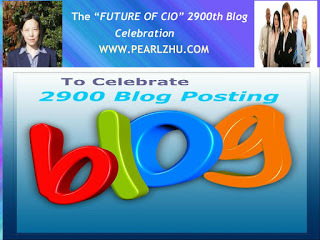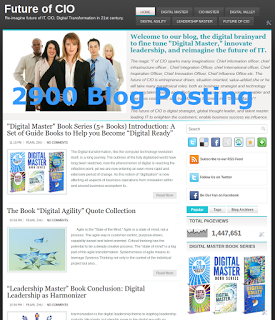Pearl Zhu's Blog, page 1324
June 26, 2016
How to Build a CHANGEABLE Organization Riding Above the Learning Curve
 Change is inevitable, and the speed of change is increasing. However, organizational change is always difficult. How can you ride above the learning curve, is there any ideal path to change, how to improve the success rate of change management and build change as an ongoing capability of the organization?
Change is inevitable, and the speed of change is increasing. However, organizational change is always difficult. How can you ride above the learning curve, is there any ideal path to change, how to improve the success rate of change management and build change as an ongoing capability of the organization?
Learning Curve awareness: Most of changes are complex processes. There is a learning curve behind them. How do you make changes to anything without knowing all the parts and how they are related? In order to make effective changes, you have to know the underneath structure and processes of your business, because they underpin digital capabilities of the organization. In practice, a mature organization is one that can quickly and safely assess all of the consequences of a possible change and devise effective plans to provide a combination approach for having both sense of urgency and overcoming change curve, to achieve and sustain those changes - and to do this continuously. Having curve awareness also means that change leaders need to master the psychological process behind changes. It takes a lot of effort and resource to make change happen. Therefore, it’s important to first understand how much change capability (people, process, and technology) is really required for the effort you are kicking off. An honest assessment of the lessons learned from previous change management projects could be a good place to begin with. The logical assessment includes all necessary steps such as curve awareness, motivation, knowledge, capability, and anchoring changes.
Systematic approach: The more complex the change, the more complex the solution. This often means customized approaches that may apply differently to each individual impacted. Too often the large scale of or transformational change is acted on the basis of improving one part of an organization at the expense of other parts of the organization. And often the middle level change managers don’t have the big picture business oversight, since they have been silo functional managers for so long, and don’t really have the change capabilities or personality traits to lead change and transformation. Change Management is all about balancing the following main elements impacting change: People, Strategies, Process and IT. And you have to maintain and fix any imbalance in those elements by establishing a cross-functional change management team to involving the management in different functions, and take a systematic approach to manage change in a holistic way. It is a change leadership practice to envision the goals of change, develop techniques and methodologies, embed innovation mechanism in change management scenario, and motivate people to ride above the learning curve and become true change agents. It is a multi-stepped process that includes both problem resolution and solution implementation. All stages must be handled with attention and proficiency to ensure success.
 The measurement of changes: Organizational change is a complex human process, management science and organizational development have often failed to measure change process, and the main source of that is the lack of multidimensional theory-based assessment instruments. Oftentimes, the organization may not have the systems and structures in place prior to implementation to actually monitor and track the change. Quantitative measures do play a valuable part in assessing, measuring, and quantifying anything. So make a measurement assessment via questioning: How do you design metrics to measure what changes and how these changes are measured? What is the relevant metrics and how can they be quantified and validated? Clearly identify where you want to be once the change is complete? And establish clear, understandable, and easily calculable metrics. Ultimately the success of the change program is measured by results that are important values to the organization, and the cultural adoption of these goals is part of that measure.
The measurement of changes: Organizational change is a complex human process, management science and organizational development have often failed to measure change process, and the main source of that is the lack of multidimensional theory-based assessment instruments. Oftentimes, the organization may not have the systems and structures in place prior to implementation to actually monitor and track the change. Quantitative measures do play a valuable part in assessing, measuring, and quantifying anything. So make a measurement assessment via questioning: How do you design metrics to measure what changes and how these changes are measured? What is the relevant metrics and how can they be quantified and validated? Clearly identify where you want to be once the change is complete? And establish clear, understandable, and easily calculable metrics. Ultimately the success of the change program is measured by results that are important values to the organization, and the cultural adoption of these goals is part of that measure.
Change Management is either for innovation or improvement, to riding above the learning curve, pre-contemplation, contemplation, preparation, strategic planning, process, action, maintenance, and measurement are the logical steps in managing change scenario and build Change Management as a crucial ongoing capability to improve business agility and overall organizational maturity.
Follow us at: @Pearl_Zhu
Published on June 26, 2016 22:38
The Book “Digital Agility” Quote Collection V
 59 Agile is a metaphor to a “Learning Organization.”
59 Agile is a metaphor to a “Learning Organization.”60 Agilists are phenomenally disciplined in focusing on value, prioritizing, executing, and collaborating.
61 Being agile means anticipating likely change and addressing it deftly, keeping business on course and customers satisfied.
62 The strategic planning and agility need to achieve contradictory coherence with such delicate balance.
63 An agile culture is not the result of a scalable process, but of adaptive mind and scalable behavior.
64 Systemicness of agile means to leverage Systems THinking not only in the context of the individual project, but also to be considered at the enterprise level.
65 The interactions between Agile values, principles, and practices are tightly coupled.
66 From doing agile to being agile, achieving agility is a strategic priority for any high mature digital organizations.
67 Agile is a paradox because it is not lack of disciplines, but needs to be more disciplined.
68 Agile stifles innovation when stakeholders dictate “how” and not get “why,” and “what.”
69 Self-organization directs the individual perspectives into a creative, adaptive, iterative and incremental problem-solving approach.
70 Senior management needs to focus more on agile philosophy, principles, and management discipline.
 71 Software development is both science and art work, “productivity” implies both quality and quantity.
71 Software development is both science and art work, “productivity” implies both quality and quantity.
72 The Agile leaders have to listen to all demands and decide the path ahead.
73 Doing Agile is only an engineering practice, but being agile is he multidisciplinary challenge from top-down and bottom-up.74 The twin goals of an Agile transformation are to increase value received and decrease risk.
75 Agility involves the whole ecosystem.Follow us at: @Pearl_Zhu
Published on June 26, 2016 22:35
June 25, 2016
"CIO Master" Book Tuning: Closing Three Gaps to Run an Innovative IT
Innovation becomes simply “creating value by solving simple or complex problems.”
 Digital CIOs have many personas indicated in the “I” of the CIO title, “Chief Innovation Officer” is one of the most pertinent roles they need to fulfill, Because more often than not, technology is the disruptive force of innovation, and information is the very clue to developing the next and best products or service, as well as delighting customers. A great CIO with their finger on the pulse of technological advancement or information insight can provide many ideas on how new technology and abundance of information can create fresh new opportunities. The point is: What are innovation gaps organizations need to bridge, how can a CIO build a solid innovation agenda, and play such a digital role more effectively?
Digital CIOs have many personas indicated in the “I” of the CIO title, “Chief Innovation Officer” is one of the most pertinent roles they need to fulfill, Because more often than not, technology is the disruptive force of innovation, and information is the very clue to developing the next and best products or service, as well as delighting customers. A great CIO with their finger on the pulse of technological advancement or information insight can provide many ideas on how new technology and abundance of information can create fresh new opportunities. The point is: What are innovation gaps organizations need to bridge, how can a CIO build a solid innovation agenda, and play such a digital role more effectively?
Idea gaps: Innovation becomes simply “creating value by solving simple or complex problems.” It’s the state of mind to think and do things from a new angle, and it’s the business unique capability to gain a competitive advantage in the face of hyper-fierce competition and business dynamic. If there is an idea gap, it means the root cause of the gap may have something to do with corporate culture. An adaptive culture makes innovation and improvement easier, it’s easier to collect, facilitate, and manage ideas more optimally. Also, if you get the culture right, then people feel they have the freedom to try and even to fail. There are many forms of innovation: technology, application, product, design, business model, process, communication, customer experience, etc. If you develop the right culture, through the effective change management if necessary, and then everything else can be connected. The cause of idea gap is also about the talent gap. The heterogeneous team with cognitive differences is more innovative than the homogeneous group setting. With building a culture of innovation and risk tolerance, people are more open to trying new things and share thoughts and ideas fearlessly, so the the fountain of ideas can flow effortlessly.
Process gap: Innovation is not a serendipity, it takes a systematic approach with a robust, but not overly rigid process to implement it. When the ideas have been developed or when they are able to be applied to meet a short-term objective, then they should be pushed through an efficient execution process. The agile innovation processes and efficient tools enable the idea flow of generation, brainstorming, contribution, evaluation, selection, and innovation execution stays totally connected. More organizations look for integration with portfolio management tools to ensure the ideas go straight from the systems into specialized tools to help manage the portfolio of potential projects, set the right priority, and leverage time and resource for improving the success rate of innovation.
 Innovation execution gap: Even you have ample innovative ideas, it doesn’t guarantee innovation success due to the possible execution gap. Bridging innovation execution gap requires a systematic execution scenario with clear stages, performance thresholds, decision-making parameters combined with the iterative learning process that supports wide-ranging exploration at each stage. Further, innovation execution is an integral part of business strategy execution, because innovation is an important component of organizational strategy. Hence, to bridge innovation execution gap is to de-risk the introduction of innovation into the market, protecting existing operations and brands, and establishing clear proof-of-concept before making investments to launch and scale up. Organizations can be more effective in executing innovative ideas by relying less on silo functions, more on cross-functional collaboration and continuous improvement. Innovation execution is an integral part of strategy-execution continuum.
Innovation execution gap: Even you have ample innovative ideas, it doesn’t guarantee innovation success due to the possible execution gap. Bridging innovation execution gap requires a systematic execution scenario with clear stages, performance thresholds, decision-making parameters combined with the iterative learning process that supports wide-ranging exploration at each stage. Further, innovation execution is an integral part of business strategy execution, because innovation is an important component of organizational strategy. Hence, to bridge innovation execution gap is to de-risk the introduction of innovation into the market, protecting existing operations and brands, and establishing clear proof-of-concept before making investments to launch and scale up. Organizations can be more effective in executing innovative ideas by relying less on silo functions, more on cross-functional collaboration and continuous improvement. Innovation execution is an integral part of strategy-execution continuum.
Leading only with operational considerations is not the way forward. IT success needs to be accompanied by working with business partners to inspire creativity, and leverage opportunities for changing how the business competes in the marketplace. Running IT as an innovation engine needs to close these gaps, keep the balance of business bottom line and taking innovation practice, in order to unleash the full digital potential of the business.
CIO Master Order Link on Amazon CIO Master Ordre Link on Barner & Noble CIO Master Order Link On IBooks “CIO Master” Book Preview Quote Collection III “CIO Master” Book Preview Quote Collection II “CIO Master” Book Preview Quote Collection I, Slideshare Presentation “CIO Master” Book Preview Conclusion Running IT as Digital Transformer “CIO Master” Book Preview: Chapter 9 IT Agility “CIO Master” Book Preview: Chapter 8 Three "P"s in Running Digital IT “CIO Master” Book Preview: Chapter 7 IT Innovation Management “CIO Master” Book Preview: Chapter 6 Digital Strategy-Execution Continuum "CIO Master” Book Preview: Chapter 5 Thirteen Digital Flavored IT “CIO Master” Book Preview: Chapter 4 CIO as Talent Master Introduction “CIO Master” Book Preview: Chapter 3 “CIOs as Change Agent” Introduction “CIO Master” Book Preview: Chapter 2 “CIOs as Digital Visionary” Introduction “CIO Master” Book Preview: Chapter 1 “Twelve Digital CIO Personas” Introduction "CIO Master - Unleash the Digital Potential of IT" Introduction "CIO Master - Unleash the Digital Potential of IT" Book Preview
Follow us at: @Pearl_Zhu
 Digital CIOs have many personas indicated in the “I” of the CIO title, “Chief Innovation Officer” is one of the most pertinent roles they need to fulfill, Because more often than not, technology is the disruptive force of innovation, and information is the very clue to developing the next and best products or service, as well as delighting customers. A great CIO with their finger on the pulse of technological advancement or information insight can provide many ideas on how new technology and abundance of information can create fresh new opportunities. The point is: What are innovation gaps organizations need to bridge, how can a CIO build a solid innovation agenda, and play such a digital role more effectively?
Digital CIOs have many personas indicated in the “I” of the CIO title, “Chief Innovation Officer” is one of the most pertinent roles they need to fulfill, Because more often than not, technology is the disruptive force of innovation, and information is the very clue to developing the next and best products or service, as well as delighting customers. A great CIO with their finger on the pulse of technological advancement or information insight can provide many ideas on how new technology and abundance of information can create fresh new opportunities. The point is: What are innovation gaps organizations need to bridge, how can a CIO build a solid innovation agenda, and play such a digital role more effectively?Idea gaps: Innovation becomes simply “creating value by solving simple or complex problems.” It’s the state of mind to think and do things from a new angle, and it’s the business unique capability to gain a competitive advantage in the face of hyper-fierce competition and business dynamic. If there is an idea gap, it means the root cause of the gap may have something to do with corporate culture. An adaptive culture makes innovation and improvement easier, it’s easier to collect, facilitate, and manage ideas more optimally. Also, if you get the culture right, then people feel they have the freedom to try and even to fail. There are many forms of innovation: technology, application, product, design, business model, process, communication, customer experience, etc. If you develop the right culture, through the effective change management if necessary, and then everything else can be connected. The cause of idea gap is also about the talent gap. The heterogeneous team with cognitive differences is more innovative than the homogeneous group setting. With building a culture of innovation and risk tolerance, people are more open to trying new things and share thoughts and ideas fearlessly, so the the fountain of ideas can flow effortlessly.
Process gap: Innovation is not a serendipity, it takes a systematic approach with a robust, but not overly rigid process to implement it. When the ideas have been developed or when they are able to be applied to meet a short-term objective, then they should be pushed through an efficient execution process. The agile innovation processes and efficient tools enable the idea flow of generation, brainstorming, contribution, evaluation, selection, and innovation execution stays totally connected. More organizations look for integration with portfolio management tools to ensure the ideas go straight from the systems into specialized tools to help manage the portfolio of potential projects, set the right priority, and leverage time and resource for improving the success rate of innovation.
 Innovation execution gap: Even you have ample innovative ideas, it doesn’t guarantee innovation success due to the possible execution gap. Bridging innovation execution gap requires a systematic execution scenario with clear stages, performance thresholds, decision-making parameters combined with the iterative learning process that supports wide-ranging exploration at each stage. Further, innovation execution is an integral part of business strategy execution, because innovation is an important component of organizational strategy. Hence, to bridge innovation execution gap is to de-risk the introduction of innovation into the market, protecting existing operations and brands, and establishing clear proof-of-concept before making investments to launch and scale up. Organizations can be more effective in executing innovative ideas by relying less on silo functions, more on cross-functional collaboration and continuous improvement. Innovation execution is an integral part of strategy-execution continuum.
Innovation execution gap: Even you have ample innovative ideas, it doesn’t guarantee innovation success due to the possible execution gap. Bridging innovation execution gap requires a systematic execution scenario with clear stages, performance thresholds, decision-making parameters combined with the iterative learning process that supports wide-ranging exploration at each stage. Further, innovation execution is an integral part of business strategy execution, because innovation is an important component of organizational strategy. Hence, to bridge innovation execution gap is to de-risk the introduction of innovation into the market, protecting existing operations and brands, and establishing clear proof-of-concept before making investments to launch and scale up. Organizations can be more effective in executing innovative ideas by relying less on silo functions, more on cross-functional collaboration and continuous improvement. Innovation execution is an integral part of strategy-execution continuum.
Leading only with operational considerations is not the way forward. IT success needs to be accompanied by working with business partners to inspire creativity, and leverage opportunities for changing how the business competes in the marketplace. Running IT as an innovation engine needs to close these gaps, keep the balance of business bottom line and taking innovation practice, in order to unleash the full digital potential of the business.
CIO Master Order Link on Amazon CIO Master Ordre Link on Barner & Noble CIO Master Order Link On IBooks “CIO Master” Book Preview Quote Collection III “CIO Master” Book Preview Quote Collection II “CIO Master” Book Preview Quote Collection I, Slideshare Presentation “CIO Master” Book Preview Conclusion Running IT as Digital Transformer “CIO Master” Book Preview: Chapter 9 IT Agility “CIO Master” Book Preview: Chapter 8 Three "P"s in Running Digital IT “CIO Master” Book Preview: Chapter 7 IT Innovation Management “CIO Master” Book Preview: Chapter 6 Digital Strategy-Execution Continuum "CIO Master” Book Preview: Chapter 5 Thirteen Digital Flavored IT “CIO Master” Book Preview: Chapter 4 CIO as Talent Master Introduction “CIO Master” Book Preview: Chapter 3 “CIOs as Change Agent” Introduction “CIO Master” Book Preview: Chapter 2 “CIOs as Digital Visionary” Introduction “CIO Master” Book Preview: Chapter 1 “Twelve Digital CIO Personas” Introduction "CIO Master - Unleash the Digital Potential of IT" Introduction "CIO Master - Unleash the Digital Potential of IT" Book Preview
Follow us at: @Pearl_Zhu
Published on June 25, 2016 22:35
Closing Three Gaps to Run an Innovative IT
 Digital CIOs have many personas indicated in the “I” of CIO title, “Chief Innovation Officer” is one the most pertinent roles they need to fulfill, Because more often than not, technology the disruptive force of innovation, and information is the very clue to developing the next and best products or service, as well as delight customers. A great CIO with their finger on the pulse of technological advancement or information insight can provide many ideas on how new technology and abundance of information could create fresh new opportunities. The point is: What are innovation gaps organizations need to bridge, how can CIOs build a solid innovation agenda, and play such a digital role more effectively?
Digital CIOs have many personas indicated in the “I” of CIO title, “Chief Innovation Officer” is one the most pertinent roles they need to fulfill, Because more often than not, technology the disruptive force of innovation, and information is the very clue to developing the next and best products or service, as well as delight customers. A great CIO with their finger on the pulse of technological advancement or information insight can provide many ideas on how new technology and abundance of information could create fresh new opportunities. The point is: What are innovation gaps organizations need to bridge, how can CIOs build a solid innovation agenda, and play such a digital role more effectively?Idea gaps: Innovation becomes simply “creating value by solving simple or complex problems.” It’s the state of mind to think and do things from a new angle, and it’s the business unique capability to gain a competitive advantage in the face of hyper-fierce competition and business dynamic. If there is an idea gap, it means the root cause of the gap may have something to do with corporate culture. An adaptive culture makes innovation and improvement easier. IT’s easier to collect, facilitate, and manage ideas more optimally. Also, if you get the culture right, then people feel they have the freedom to try and even to fail. There are many forms of innovation: technology, application, product, design, business model, process, communication, customer experience, etc. If you develop the right culture, through the effective change management if necessary, and then everything else can be connected. The cause of idea gap is also about the talent gap. The heterogeneous team with cognitive differences is more innovative than the homogeneous group setting. With building a culture of innovation and risk tolerance, people are more open to trying new things and share thoughts and ideas fearlessly.
Process gap: Innovation is not a serendipity, it takes a systematic approach with a robust, but not overly rigid process to implement it. When the ideas have been developed or when they are able to be applied to meet a short-term objective, and they should be pushed through an efficient execution process. The agile innovation processes and efficient tools enable the idea flow of generation, brainstorming, contribution, evaluation, selection, and innovation execution stays totally connected. More organizations look for integration with portfolio management tools to ensure the ideas go straight from the systems into specialized tools to help manage the portfolio of potential projects, set the right priority, and leverage time and resource for improving the success rate of innovation.
 Innovation execution gap: Even you have ample innovative ideas, it doesn’t guarantee innovation success due to the possible execution gap. Bridging innovation execution gap requires a systematic execution scenario with clear stages, performance thresholds, decision-making parameters combined with the iterative learning process that supports wide-ranging exploration at each stage. Further, innovation execution is an integral part of business strategy execution, because innovation is an important component of organizational strategy. Hence to bridge innovation execution gap is to de-risk the introduction of innovation into the market, protecting existing operations and brands, and establishing clear proof-of-concept before making investments to launch and scale up. Organizations can be more effective in executing innovative ideas by relying less on silo functions, more on cross-functional collaboration and continuous improvement.
Innovation execution gap: Even you have ample innovative ideas, it doesn’t guarantee innovation success due to the possible execution gap. Bridging innovation execution gap requires a systematic execution scenario with clear stages, performance thresholds, decision-making parameters combined with the iterative learning process that supports wide-ranging exploration at each stage. Further, innovation execution is an integral part of business strategy execution, because innovation is an important component of organizational strategy. Hence to bridge innovation execution gap is to de-risk the introduction of innovation into the market, protecting existing operations and brands, and establishing clear proof-of-concept before making investments to launch and scale up. Organizations can be more effective in executing innovative ideas by relying less on silo functions, more on cross-functional collaboration and continuous improvement.
Leading only with operational considerations is not the way forward. IT success needs to be accompanied by working with business partners to inspire creativity, and leverage opportunities for changing how the business competes in the marketplace. Running IT as an innovation engine needs to close these gaps, keep the balance of bottom line and innovation practice, in order to unleash the full digital potential of the business.
Follow us at: @Pearl_Zhu
Published on June 25, 2016 22:35
The “Digital Agility” Quote Collection IV
 46 Business agility is the capability to adapt to changes.
46 Business agility is the capability to adapt to changes.
47 For Agile, the old saying may still work - you get what you measure.
48 The goal of measurement is to not only do things right but do the right things and continuously improve doing that.
49 Senior executives are more interested in “value realized” by the organization than the “value delivery” by the team.
50 If you want to measure agility, you need to be able to measure how well your organizations can respond.
51 “Agility” is a philosophy of managing complexity and unpredictability through empiricism.
52 Measuring Agile maturity at both macro level and micro level.
53 The overall organizational health needs to be measured via employee engagement, culture readiness, business agility, and customer-centricity, etc.
 54 An agile organization is one that is open to change and can adapt readily when change is needed.
54 An agile organization is one that is open to change and can adapt readily when change is needed.
55 Doing Agile is only an engineering practice, but being agile is the multidisciplinary challenge from the top down and bottom up.
56 Overall, Agile is a mindset change - from doing agile to being agile; from agile newbie to high-performing agilist.
57 Agile is neither a golden hammer nor a silver bullet, it is more like a silver mirror, you need to make continuous reflection and improvement.
58 Being agile is about continuous improvement.Follow us at: @Pearl_Zhu
Published on June 25, 2016 22:31
June 24, 2016
Three Levels of Understanding
Lack of knowledge is circumstantial; poor manner is tolerable. But lack of in-depth understanding is often fatal and create more problems in this world.
 With today’s digital new normal - complexity, uncertainty and ambiguity, in-depth understanding of either problems you intend to solve or the people you try to get knowing has become an important quality for digital leaders and professionals. Because often misunderstanding or poor judgment is the root cause to tie the knots in people’s hearts and build the wall in their minds. Lack of understanding is the very reason for “fixing the symptom, not the root cause,” and more fatally cause the “Mighty Fall.” Which level of understanding do you have when facing challenges, building relationships, or practicing leadership disciplines?
With today’s digital new normal - complexity, uncertainty and ambiguity, in-depth understanding of either problems you intend to solve or the people you try to get knowing has become an important quality for digital leaders and professionals. Because often misunderstanding or poor judgment is the root cause to tie the knots in people’s hearts and build the wall in their minds. Lack of understanding is the very reason for “fixing the symptom, not the root cause,” and more fatally cause the “Mighty Fall.” Which level of understanding do you have when facing challenges, building relationships, or practicing leadership disciplines?
Content understanding: Understanding requires a person's ability to grasp or comprehend information. How deep your understanding is based on the logic, lenses, philosophy, mindset, methodology you leverage to interpret things. If we look at all languages, there are certain UNIVERSAL features of all languages, like subjects and objects, verbs, nouns, adjectives, and adverbs. These universal features say something about the world, and content understanding often explains things in a conventional way. In the case of language, we can start from a conventional meaning: language as a method of communicating thoughts. Often people follow conventional wisdom and get stuck only at the level of content understanding, explain things based on the linguistic meaning or make observation on the surface level. They are constrained by the little box in which they are familiar with or just follow other people’s explanation without digging further. Thus, too often, assumptions and prejudices get in the way of understanding. It is the responsibility of each individual to examine themselves and to make sure they are open to true understanding, it means you need to get further steps and reach the next level of understanding (in-depth way).
Contextual understanding: Even at linguistic level, you can not conceive a language without context. Logic was discovered through an analysis of language. In that sense language is prior to logic, but more precisely, logic is a part of language, a deep part of the language that was always there and is discovered by an analysis of language, or doing philosophy of language as Aristotle did to discover the syllogism. At today’s digital world, logic is often nonlinear and multidimensional. If you want to discover the essential meaning of a term, you must be prepared to go beyond thinking that confines itself to just things; you must be prepared to go to the ontological ground about which that term speaks. Keep in mind, words are said to be the second order. Thoughts are the first order. However, once thoughts have been accessible to others through language or action, we reach a stage to assess the logic of everything; thoughts, language, actions. Logic is a part of the language, a deep structure of language. Therefore, contextual understanding digs deeper, to touch the thought processes and logical reasoning, not only about word meaning, but also about the tones, and “wholeness.” In the digital working environment, context intelligence is about understanding the whole meaning of functional dialects and business cultures or subcultures,
 Wisdom abstraction: Knowledge-understanding-wisdom, it is the pyramid you need to climb for gaining in-depth understanding. Wisdom comes through the result of life experience or knowledge transcendence. Knowledge is concrete, understanding is personal, and wisdom is abstract. Wisdom is about independent thinking and creativity; putting aside all the trained thoughts, systems, and boxes, let the open possibility come connect naturally. Independent Thinking means you do not follow others' opinion blindly, but analyze and synthesize all sources of input and information to form your own opinion. When in-depth thoughts and understanding transcend into wisdom, the good solution to a specific problem can be scaled and applied to other domains; the mindsets with cognitive difference can be connected via empathy and the hearts can be touched via positive emotion flows.
Wisdom abstraction: Knowledge-understanding-wisdom, it is the pyramid you need to climb for gaining in-depth understanding. Wisdom comes through the result of life experience or knowledge transcendence. Knowledge is concrete, understanding is personal, and wisdom is abstract. Wisdom is about independent thinking and creativity; putting aside all the trained thoughts, systems, and boxes, let the open possibility come connect naturally. Independent Thinking means you do not follow others' opinion blindly, but analyze and synthesize all sources of input and information to form your own opinion. When in-depth thoughts and understanding transcend into wisdom, the good solution to a specific problem can be scaled and applied to other domains; the mindsets with cognitive difference can be connected via empathy and the hearts can be touched via positive emotion flows.
The ability to understand or teach is due to the intellect present within the person. The most important capability of cognitive mind is the willingness and ability to seek out acknowledge, and address our ignorance and the assumptions we make to minimize it. Misunderstanding is the big cause of many human problems. First understand, and then be understood, in this order. Sufficient, especially interdisciplinary knowledge is fundamental to spark creativity and gain insight. Only through in-depth understanding, knowledge can be refined to insight and abstract to wisdom.
Follow us at: @Pearl_Zhu
 With today’s digital new normal - complexity, uncertainty and ambiguity, in-depth understanding of either problems you intend to solve or the people you try to get knowing has become an important quality for digital leaders and professionals. Because often misunderstanding or poor judgment is the root cause to tie the knots in people’s hearts and build the wall in their minds. Lack of understanding is the very reason for “fixing the symptom, not the root cause,” and more fatally cause the “Mighty Fall.” Which level of understanding do you have when facing challenges, building relationships, or practicing leadership disciplines?
With today’s digital new normal - complexity, uncertainty and ambiguity, in-depth understanding of either problems you intend to solve or the people you try to get knowing has become an important quality for digital leaders and professionals. Because often misunderstanding or poor judgment is the root cause to tie the knots in people’s hearts and build the wall in their minds. Lack of understanding is the very reason for “fixing the symptom, not the root cause,” and more fatally cause the “Mighty Fall.” Which level of understanding do you have when facing challenges, building relationships, or practicing leadership disciplines?
Content understanding: Understanding requires a person's ability to grasp or comprehend information. How deep your understanding is based on the logic, lenses, philosophy, mindset, methodology you leverage to interpret things. If we look at all languages, there are certain UNIVERSAL features of all languages, like subjects and objects, verbs, nouns, adjectives, and adverbs. These universal features say something about the world, and content understanding often explains things in a conventional way. In the case of language, we can start from a conventional meaning: language as a method of communicating thoughts. Often people follow conventional wisdom and get stuck only at the level of content understanding, explain things based on the linguistic meaning or make observation on the surface level. They are constrained by the little box in which they are familiar with or just follow other people’s explanation without digging further. Thus, too often, assumptions and prejudices get in the way of understanding. It is the responsibility of each individual to examine themselves and to make sure they are open to true understanding, it means you need to get further steps and reach the next level of understanding (in-depth way).
Contextual understanding: Even at linguistic level, you can not conceive a language without context. Logic was discovered through an analysis of language. In that sense language is prior to logic, but more precisely, logic is a part of language, a deep part of the language that was always there and is discovered by an analysis of language, or doing philosophy of language as Aristotle did to discover the syllogism. At today’s digital world, logic is often nonlinear and multidimensional. If you want to discover the essential meaning of a term, you must be prepared to go beyond thinking that confines itself to just things; you must be prepared to go to the ontological ground about which that term speaks. Keep in mind, words are said to be the second order. Thoughts are the first order. However, once thoughts have been accessible to others through language or action, we reach a stage to assess the logic of everything; thoughts, language, actions. Logic is a part of the language, a deep structure of language. Therefore, contextual understanding digs deeper, to touch the thought processes and logical reasoning, not only about word meaning, but also about the tones, and “wholeness.” In the digital working environment, context intelligence is about understanding the whole meaning of functional dialects and business cultures or subcultures,
 Wisdom abstraction: Knowledge-understanding-wisdom, it is the pyramid you need to climb for gaining in-depth understanding. Wisdom comes through the result of life experience or knowledge transcendence. Knowledge is concrete, understanding is personal, and wisdom is abstract. Wisdom is about independent thinking and creativity; putting aside all the trained thoughts, systems, and boxes, let the open possibility come connect naturally. Independent Thinking means you do not follow others' opinion blindly, but analyze and synthesize all sources of input and information to form your own opinion. When in-depth thoughts and understanding transcend into wisdom, the good solution to a specific problem can be scaled and applied to other domains; the mindsets with cognitive difference can be connected via empathy and the hearts can be touched via positive emotion flows.
Wisdom abstraction: Knowledge-understanding-wisdom, it is the pyramid you need to climb for gaining in-depth understanding. Wisdom comes through the result of life experience or knowledge transcendence. Knowledge is concrete, understanding is personal, and wisdom is abstract. Wisdom is about independent thinking and creativity; putting aside all the trained thoughts, systems, and boxes, let the open possibility come connect naturally. Independent Thinking means you do not follow others' opinion blindly, but analyze and synthesize all sources of input and information to form your own opinion. When in-depth thoughts and understanding transcend into wisdom, the good solution to a specific problem can be scaled and applied to other domains; the mindsets with cognitive difference can be connected via empathy and the hearts can be touched via positive emotion flows.
The ability to understand or teach is due to the intellect present within the person. The most important capability of cognitive mind is the willingness and ability to seek out acknowledge, and address our ignorance and the assumptions we make to minimize it. Misunderstanding is the big cause of many human problems. First understand, and then be understood, in this order. Sufficient, especially interdisciplinary knowledge is fundamental to spark creativity and gain insight. Only through in-depth understanding, knowledge can be refined to insight and abstract to wisdom.
Follow us at: @Pearl_Zhu
Published on June 24, 2016 23:39
The Book “Digital Agility” Quotes Collection
Agile is a set of principles. Agile doesn’t mean to take less discipline, but more.
 31 Agile is about failing your way to success and impact. It is also about doing the right things before doing things right.
31 Agile is about failing your way to success and impact. It is also about doing the right things before doing things right.
32 There are many roadblocks on the Agile way: from mindset to culture of mediocre; from misunderstanding to lack of focus.
33 The agile way is more adapt to changes, but shall not lose the sight of big picture.
34 You can only fail better only if you learn from failures. And then failing is something that prompts you to move ahead.
35 Doing Agile is just a first step; being agile needs to have a totally different mindset, and multidimensional perspectives.
36 Agile is not just a methodology, but a set of principles and philosophy.
37 Agility within and of itself is a strategy.
38 The well-defined principles last when time moves on. However, a progressive organization or society will love to break the old or hidden rules in order to move forward.
39 Both Agile and DevOps are for harnessing integration, interaction, and innovation.
40 Agility should not be translated to sacrificing planning, management guidelines, and quality assurance.
41 On a digital continuum, you’d have well-defined process on one end, and loosely defined practices on the other end.
42 Agile does not mean laissez-faire, flexibility and freedom are based on the well-defined principles.
43 The beauty of agile comes in with its incremental nature and use of empiricism to focus on three “I”s - Interaction, Iteration, and Improvement.
44 Change is not for its own sake, it’s the means to the end, not the end.
45 Agile is people-dependent. This is certainly not specific to Agile.Follow us at: @Pearl_Zhu
 31 Agile is about failing your way to success and impact. It is also about doing the right things before doing things right.
31 Agile is about failing your way to success and impact. It is also about doing the right things before doing things right.
32 There are many roadblocks on the Agile way: from mindset to culture of mediocre; from misunderstanding to lack of focus.
33 The agile way is more adapt to changes, but shall not lose the sight of big picture.
34 You can only fail better only if you learn from failures. And then failing is something that prompts you to move ahead.
35 Doing Agile is just a first step; being agile needs to have a totally different mindset, and multidimensional perspectives.
36 Agile is not just a methodology, but a set of principles and philosophy.
37 Agility within and of itself is a strategy.
38 The well-defined principles last when time moves on. However, a progressive organization or society will love to break the old or hidden rules in order to move forward.
39 Both Agile and DevOps are for harnessing integration, interaction, and innovation.
40 Agility should not be translated to sacrificing planning, management guidelines, and quality assurance.
41 On a digital continuum, you’d have well-defined process on one end, and loosely defined practices on the other end.
42 Agile does not mean laissez-faire, flexibility and freedom are based on the well-defined principles.
43 The beauty of agile comes in with its incremental nature and use of empiricism to focus on three “I”s - Interaction, Iteration, and Improvement.
44 Change is not for its own sake, it’s the means to the end, not the end.
45 Agile is people-dependent. This is certainly not specific to Agile.Follow us at: @Pearl_Zhu
Published on June 24, 2016 23:38
“CIO Master” Book Tuning XXXXI: Three Aspects in Running a Digital-Ready IT
A Digital-Ready IT is a thresholding competency of the organization, and an enabler of business digital capability.
 Either running IT or managing the organization as a whole, being digitally ready goes beyond just applying the latest technologies or playing the trendy gadgets. The management has to follow digital principles and take a structured approach to shifting from inside-out operation focus to outside-in customer-centric. Digital transformation starts with mindshift, business value has to be driven, indicated and understood at all levels of the organization. This is accomplished by establishing strong interdependent relationships, the shared vision, and wisdom. Here are three aspects of running a digital-ready IT organization.
Either running IT or managing the organization as a whole, being digitally ready goes beyond just applying the latest technologies or playing the trendy gadgets. The management has to follow digital principles and take a structured approach to shifting from inside-out operation focus to outside-in customer-centric. Digital transformation starts with mindshift, business value has to be driven, indicated and understood at all levels of the organization. This is accomplished by establishing strong interdependent relationships, the shared vision, and wisdom. Here are three aspects of running a digital-ready IT organization.
Digital-Ready IT leadership: As a leader, the CIO has to be able to inspire and encourage with his/her vision and generate conviction and enthusiasm for the missions of the company and the IT division, regardless of how exciting or mundane they may be. CIOs need to build hardcore expertise and develop skills beyond technology, based on the understanding of their particular organization's current and potential corporate structure, and strategic plan. CIOs should be part of the top management team providing his/her inputs on the business strategies and decisions and their impact. CIOs need to develop a broad set of skills and capabilities beyond technology, coupled with the ability to understand, and translate “tech-talk” to business conversation. Among other skills, they need strong business orientation and a proven ability to bring the benefits of IT to solve business issues. Every top executive should make their voice heard on this front, have an opportunity and responsibility to participate in the strategic discussion, innovation dialog and to come up with creative ideas, most of the functions can make process innovation within their division, IT, on the other hand, which is in a unique position to get amazing 360 degrees view of the businesses, process, and challenges required to integrate the organization together, has much more of an opportunity to enable incremental top-line and bottom-line value across the business, not just within IT, but at the organizational scope, even across the digital business ecosystem.
Digital-Ready Enterprise Capability: It’s not sufficient to run IT as a service provider or process tuner only. IT needs to become a business solutionary and enterprise capability builder. IT is not just a support center with monolithic hardware only, IT needs to run with a software startup mentality and build capability based unique business competency via weaving all necessary hard and soft elements, in reaching high-level maturity. Each of these same capabilities may be combined in different fashions to yield multiple competencies. Organization can achieve capability-based strategy seamlessly, so the firm can exist, thrive, and generate a suitable return as an outcome of being competitively advantageous. More specifically, digital-ready enterprise capabilities will enhance: -Customer satisfaction (both internal IT customers and end customers accordingly)- Value of IT to the business-Projects delivered on value (beyond just on time & budget)- Innovation Management- IT performance management for both bottom line “keep the light on” and top line revenue contribution.- Business cost optimization
 Digital-ready talent management: IT talent shortage is the reality. If at the traditional setting of IT organizations, IT professionals are expected to take orders only, and accomplish the static tasks repetitively without breaking the mode of “we always do things this way.” Or IT recruiting approach only focuses on short-term immediate need for the handy project, without long term talent planning to align with business strategy. So, with the rapidly change in the digital era, Talent Management is throwing fresh challenges and calls for radical change to be embraced. There are large skill gaps existing in many IT organizations, they fail to keep up on standards within their domain that can lead to the holistic enterprise viewpoint, and execution of IT strategies that fit within that enterprise viewpoint. Talent competency is the digital lenses through which people managers can assess talent in more strategic, analytical and creative way. The best or the right people are the cornerstones of the best IT organizations; while the best teams with complementary thinking style, skills, and capability can achieve much more than any individual who performs on his or her own. Assess professional traits on which competencies are built. The integrity and suitability of the competency are tested through traits such as critical thinking, creative thinking, attitude, passion, entrepreneurship, leadership, maturity, and wisdom, etc.
Digital-ready talent management: IT talent shortage is the reality. If at the traditional setting of IT organizations, IT professionals are expected to take orders only, and accomplish the static tasks repetitively without breaking the mode of “we always do things this way.” Or IT recruiting approach only focuses on short-term immediate need for the handy project, without long term talent planning to align with business strategy. So, with the rapidly change in the digital era, Talent Management is throwing fresh challenges and calls for radical change to be embraced. There are large skill gaps existing in many IT organizations, they fail to keep up on standards within their domain that can lead to the holistic enterprise viewpoint, and execution of IT strategies that fit within that enterprise viewpoint. Talent competency is the digital lenses through which people managers can assess talent in more strategic, analytical and creative way. The best or the right people are the cornerstones of the best IT organizations; while the best teams with complementary thinking style, skills, and capability can achieve much more than any individual who performs on his or her own. Assess professional traits on which competencies are built. The integrity and suitability of the competency are tested through traits such as critical thinking, creative thinking, attitude, passion, entrepreneurship, leadership, maturity, and wisdom, etc.
In today’s digital dynamic and technical environments where IT is being used more and more around the globe for revenue generating initiatives and the business is becoming IT. A Digital-Ready IT is a thresholding competency of the organization, it is an enabler of business digital capability, goes beyond an IT-business alignment stage, and move up to integration and engagement level. IT can weave all necessary business elements, either hard or soft, to orchestrate a digital symphony.
CIO Master Order Link on Amazon CIO Master Ordre Link on Barner & Noble CIO Master Order Link On IBooks “CIO Master” Book Preview Quote Collection III “CIO Master” Book Preview Quote Collection II “CIO Master” Book Preview Quote Collection I, Slideshare Presentation “CIO Master” Book Preview Conclusion Running IT as Digital Transformer “CIO Master” Book Preview: Chapter 9 IT Agility “CIO Master” Book Preview: Chapter 8 Three "P"s in Running Digital IT “CIO Master” Book Preview: Chapter 7 IT Innovation Management “CIO Master” Book Preview: Chapter 6 Digital Strategy-Execution Continuum "CIO Master” Book Preview: Chapter 5 Thirteen Digital Flavored IT “CIO Master” Book Preview: Chapter 4 CIO as Talent Master Introduction “CIO Master” Book Preview: Chapter 3 “CIOs as Change Agent” Introduction “CIO Master” Book Preview: Chapter 2 “CIOs as Digital Visionary” Introduction “CIO Master” Book Preview: Chapter 1 “Twelve Digital CIO Personas” Introduction "CIO Master - Unleash the Digital Potential of IT" Introduction "CIO Master - Unleash the Digital Potential of IT" Book Preview
Follow us at: @Pearl_Zhu
 Either running IT or managing the organization as a whole, being digitally ready goes beyond just applying the latest technologies or playing the trendy gadgets. The management has to follow digital principles and take a structured approach to shifting from inside-out operation focus to outside-in customer-centric. Digital transformation starts with mindshift, business value has to be driven, indicated and understood at all levels of the organization. This is accomplished by establishing strong interdependent relationships, the shared vision, and wisdom. Here are three aspects of running a digital-ready IT organization.
Either running IT or managing the organization as a whole, being digitally ready goes beyond just applying the latest technologies or playing the trendy gadgets. The management has to follow digital principles and take a structured approach to shifting from inside-out operation focus to outside-in customer-centric. Digital transformation starts with mindshift, business value has to be driven, indicated and understood at all levels of the organization. This is accomplished by establishing strong interdependent relationships, the shared vision, and wisdom. Here are three aspects of running a digital-ready IT organization.
Digital-Ready IT leadership: As a leader, the CIO has to be able to inspire and encourage with his/her vision and generate conviction and enthusiasm for the missions of the company and the IT division, regardless of how exciting or mundane they may be. CIOs need to build hardcore expertise and develop skills beyond technology, based on the understanding of their particular organization's current and potential corporate structure, and strategic plan. CIOs should be part of the top management team providing his/her inputs on the business strategies and decisions and their impact. CIOs need to develop a broad set of skills and capabilities beyond technology, coupled with the ability to understand, and translate “tech-talk” to business conversation. Among other skills, they need strong business orientation and a proven ability to bring the benefits of IT to solve business issues. Every top executive should make their voice heard on this front, have an opportunity and responsibility to participate in the strategic discussion, innovation dialog and to come up with creative ideas, most of the functions can make process innovation within their division, IT, on the other hand, which is in a unique position to get amazing 360 degrees view of the businesses, process, and challenges required to integrate the organization together, has much more of an opportunity to enable incremental top-line and bottom-line value across the business, not just within IT, but at the organizational scope, even across the digital business ecosystem.
Digital-Ready Enterprise Capability: It’s not sufficient to run IT as a service provider or process tuner only. IT needs to become a business solutionary and enterprise capability builder. IT is not just a support center with monolithic hardware only, IT needs to run with a software startup mentality and build capability based unique business competency via weaving all necessary hard and soft elements, in reaching high-level maturity. Each of these same capabilities may be combined in different fashions to yield multiple competencies. Organization can achieve capability-based strategy seamlessly, so the firm can exist, thrive, and generate a suitable return as an outcome of being competitively advantageous. More specifically, digital-ready enterprise capabilities will enhance: -Customer satisfaction (both internal IT customers and end customers accordingly)- Value of IT to the business-Projects delivered on value (beyond just on time & budget)- Innovation Management- IT performance management for both bottom line “keep the light on” and top line revenue contribution.- Business cost optimization
 Digital-ready talent management: IT talent shortage is the reality. If at the traditional setting of IT organizations, IT professionals are expected to take orders only, and accomplish the static tasks repetitively without breaking the mode of “we always do things this way.” Or IT recruiting approach only focuses on short-term immediate need for the handy project, without long term talent planning to align with business strategy. So, with the rapidly change in the digital era, Talent Management is throwing fresh challenges and calls for radical change to be embraced. There are large skill gaps existing in many IT organizations, they fail to keep up on standards within their domain that can lead to the holistic enterprise viewpoint, and execution of IT strategies that fit within that enterprise viewpoint. Talent competency is the digital lenses through which people managers can assess talent in more strategic, analytical and creative way. The best or the right people are the cornerstones of the best IT organizations; while the best teams with complementary thinking style, skills, and capability can achieve much more than any individual who performs on his or her own. Assess professional traits on which competencies are built. The integrity and suitability of the competency are tested through traits such as critical thinking, creative thinking, attitude, passion, entrepreneurship, leadership, maturity, and wisdom, etc.
Digital-ready talent management: IT talent shortage is the reality. If at the traditional setting of IT organizations, IT professionals are expected to take orders only, and accomplish the static tasks repetitively without breaking the mode of “we always do things this way.” Or IT recruiting approach only focuses on short-term immediate need for the handy project, without long term talent planning to align with business strategy. So, with the rapidly change in the digital era, Talent Management is throwing fresh challenges and calls for radical change to be embraced. There are large skill gaps existing in many IT organizations, they fail to keep up on standards within their domain that can lead to the holistic enterprise viewpoint, and execution of IT strategies that fit within that enterprise viewpoint. Talent competency is the digital lenses through which people managers can assess talent in more strategic, analytical and creative way. The best or the right people are the cornerstones of the best IT organizations; while the best teams with complementary thinking style, skills, and capability can achieve much more than any individual who performs on his or her own. Assess professional traits on which competencies are built. The integrity and suitability of the competency are tested through traits such as critical thinking, creative thinking, attitude, passion, entrepreneurship, leadership, maturity, and wisdom, etc.
In today’s digital dynamic and technical environments where IT is being used more and more around the globe for revenue generating initiatives and the business is becoming IT. A Digital-Ready IT is a thresholding competency of the organization, it is an enabler of business digital capability, goes beyond an IT-business alignment stage, and move up to integration and engagement level. IT can weave all necessary business elements, either hard or soft, to orchestrate a digital symphony.
CIO Master Order Link on Amazon CIO Master Ordre Link on Barner & Noble CIO Master Order Link On IBooks “CIO Master” Book Preview Quote Collection III “CIO Master” Book Preview Quote Collection II “CIO Master” Book Preview Quote Collection I, Slideshare Presentation “CIO Master” Book Preview Conclusion Running IT as Digital Transformer “CIO Master” Book Preview: Chapter 9 IT Agility “CIO Master” Book Preview: Chapter 8 Three "P"s in Running Digital IT “CIO Master” Book Preview: Chapter 7 IT Innovation Management “CIO Master” Book Preview: Chapter 6 Digital Strategy-Execution Continuum "CIO Master” Book Preview: Chapter 5 Thirteen Digital Flavored IT “CIO Master” Book Preview: Chapter 4 CIO as Talent Master Introduction “CIO Master” Book Preview: Chapter 3 “CIOs as Change Agent” Introduction “CIO Master” Book Preview: Chapter 2 “CIOs as Digital Visionary” Introduction “CIO Master” Book Preview: Chapter 1 “Twelve Digital CIO Personas” Introduction "CIO Master - Unleash the Digital Potential of IT" Introduction "CIO Master - Unleash the Digital Potential of IT" Book Preview
Follow us at: @Pearl_Zhu
Published on June 24, 2016 23:36
“CIO Master” Book Tuning: Three Aspects in Running a Digital-Ready IT
 Either running IT or managing the organization as a whole, being digitally ready goes beyond just applying the latest technologies or playing the trendy gadget. The management has to follow digital principles and take a structured approach to shift from inside-out operation focus to outside-in customer-centric. Digital transformation starts with mindshift, business value has to be driven, indicated and understood at all levels of the organization. This is accomplished by establishing strong interdependent relationships, the shared vision, and wisdom. Here are three aspects to run a digital-ready IT organization.
Either running IT or managing the organization as a whole, being digitally ready goes beyond just applying the latest technologies or playing the trendy gadget. The management has to follow digital principles and take a structured approach to shift from inside-out operation focus to outside-in customer-centric. Digital transformation starts with mindshift, business value has to be driven, indicated and understood at all levels of the organization. This is accomplished by establishing strong interdependent relationships, the shared vision, and wisdom. Here are three aspects to run a digital-ready IT organization.
Digital-Ready IT leadership: As a leader, the CIO has to be able to inspire and encourage with his/her vision and generate conviction and enthusiasm for the missions of the company and the IT division, regardless of how exciting or mundane they may be. CIOs need to build hardcore expertise and develop skills beyond technology, based on the understanding of their particular organization's current and potential corporate structure, and strategic plan. CIOs should be part of the top management team providing his/her inputs on the business strategies and decisions and their impact. CIOs need to develop a broad set of skills and capabilities beyond technology, coupled with the ability to understand, and translate “tech-talk” to business conversation. Among other skills, they need strong business orientation and a proven ability to bring the benefits of IT to solve business issues. Every top executive should make their voice heard on this front, have an opportunity and responsibility to participate in the strategic discussion, innovation dialog and to come up with creative ideas, most of functions can make process innovation within their division, IT, on the other hand, is in a unique position to get amazing 360 degree view of the businesses, process, and challenges required to integrate the organization together, has much more of an opportunity to enable incremental top-line and bottom-line value across the business, not just within IT, but at the organizational scope, even across the digital business ecosystem.
Digital-Ready Enterprise Capability: It’s not sufficient to run IT as a service provider or process fixer. IT needs to become a business solutionary and enterprise capability builder. IT is not just a support center with monolithic hardware only, IT needs to build capability based unique competency via weaving all necessary hard and soft elements, in reaching high-level maturity. ,Each of these same capabilities may be combined in different fashions to yield multiple competencies. Organization can achieve capability-based strategy seamlessly, so the firm can exist, thrive, and generate a suitable return as an outcome of being competitively advantageous. More specifically, digital-ready enterprise capabilities will enhance: -Customer satisfaction (both internal IT customers and end customers accordingly)- Value of IT to the business-Projects delivered on value (beyond just on time & budget)- Innovation Management- IT performance management for both bottom line “keep the light on” and top line revenue contribution.- Business cost optimization
 Digital-ready talent management: IT talent shortage is the reality. If at the traditional setting of IT organizations, IT professionals are expected to take orders only, and accomplish the static tasks repetitively without breaking the mode of “we always do things this way.” Or IT recruiting approach only focuses on short-term immediate need for the handy project, without long term talent planning to align with business strategy. So, with the rapidly change in the digital era, Talent Management is throwing fresh challenges and calls for radical change to be embraced. There are large skill gaps existing in many IT organizations, they fail to keep up on standards within their domain that can lead to the holistic enterprise viewpoint, and execution of IT strategies that fit within that enterprise viewpoint. Talent competency is the digital lenses through which people managers can assess talent in more strategic, analytical and creative way. The best or the right people are the cornerstones of the best IT organizations; while the best teams with complementary thinking style, skills, and capability can achieve much more than any individual who performs on his or her own. Assess professional traits on which competencies are built. The integrity and suitability of the competency are tested through traits such as critical thinking, creative thinking, attitude, passion, entrepreneurship, leadership, maturity, and wisdom, etc.
Digital-ready talent management: IT talent shortage is the reality. If at the traditional setting of IT organizations, IT professionals are expected to take orders only, and accomplish the static tasks repetitively without breaking the mode of “we always do things this way.” Or IT recruiting approach only focuses on short-term immediate need for the handy project, without long term talent planning to align with business strategy. So, with the rapidly change in the digital era, Talent Management is throwing fresh challenges and calls for radical change to be embraced. There are large skill gaps existing in many IT organizations, they fail to keep up on standards within their domain that can lead to the holistic enterprise viewpoint, and execution of IT strategies that fit within that enterprise viewpoint. Talent competency is the digital lenses through which people managers can assess talent in more strategic, analytical and creative way. The best or the right people are the cornerstones of the best IT organizations; while the best teams with complementary thinking style, skills, and capability can achieve much more than any individual who performs on his or her own. Assess professional traits on which competencies are built. The integrity and suitability of the competency are tested through traits such as critical thinking, creative thinking, attitude, passion, entrepreneurship, leadership, maturity, and wisdom, etc.
In today’s digital dynamic and technical environments where IT is being used more and more around the globe for revenue generating initiatives and the business is becoming IT. A Digital-Ready IT is a thresholding competency of the organization, it is an enabler of business digital capability, goes beyond an IT-business alignment stage, and move up to integration and engagement. IT can weave all necessary business elements, either hard or soft, to orchestrate a digital symphony.
Follow us at: @Pearl_Zhu
Published on June 24, 2016 23:36
June 23, 2016
To Celebrate 2900th Blog Posting: The “Digital-Ready” Portfolio Goes beyond IT
 The “Future of CIO” Blog has reached 1.3 million page views with 2900+ blog posting in 59+ different categories of leadership, management, strategy, digitalization, change/talent, etc. The content richness is not for its own sake, but to convey the vision and share the wisdom. The blog is like a dynamic digital book, to continue creating new knowledge from the old with accelerating learning cycle. Today’s forward-looking digital professionals have to learn, de-learn and re-learn all the time, craft a set of unique and recombinant digital capabilities, and build a dynamic and informative digital portfolio to make profound influence and compete for the future; and today’s digital organizations have to navigate the digital journey via planning, innovating, taking structured approaches and leveraging the right technologies, to strive for becoming digital master.
The “Future of CIO” Blog has reached 1.3 million page views with 2900+ blog posting in 59+ different categories of leadership, management, strategy, digitalization, change/talent, etc. The content richness is not for its own sake, but to convey the vision and share the wisdom. The blog is like a dynamic digital book, to continue creating new knowledge from the old with accelerating learning cycle. Today’s forward-looking digital professionals have to learn, de-learn and re-learn all the time, craft a set of unique and recombinant digital capabilities, and build a dynamic and informative digital portfolio to make profound influence and compete for the future; and today’s digital organizations have to navigate the digital journey via planning, innovating, taking structured approaches and leveraging the right technologies, to strive for becoming digital master.
2900 Blog Posting Oversight: Blogging is not about writing, but about thinking; it’s not just about WHAT to say, but about WHY to say, and HOW to say it. It reflects the color and shade of your thought patterns, and it indicates the peaks and curves of your thinking waves. Unlike pure entertainment, quality and professional content takes time for digesting, contemplation and engaging, and therefore, it takes the time to attract the "hungry minds" and the "deep souls." It’s the journey to amplify your voice, deepen your digital footprints, and match your way for human progression.
“Digital Master” Book Series Review: “Digital Master” is the series of guidebooks to perceive the multi-faceted impact digital is making to the business and workforce, and navigate the business and digital professionals toward the journey with “digital ready mindset and capabilities.”
“Digital Ready” Slideshare Presentation: Digital goes beyond technology only, it permeates every aspect of the business and personal life: From customer experience to boardroom, from daily work to strategic planning; from followship to leadership, the future is already here, but it is unevenly distributed. Great leaders can bridge today and tomorrow via their vision and creative communication.
“Digital Ready” Linkedin Posting: A digital paradigm is an emerging digital ecosystem of principles, policies, and practices to navigate uncharted water and enter to blurred boundaries; also offer the guidance for problem-solving or creating something new under the digital rules. It is the transformation that is reshaping our thinking and recasting the way we view ourselves, the systems of which we are the part of the environments in which we live, and the way we view the world. In the hyperconnected digital world, everythings is linked and interconnected with others. Therefore, digital altitude - simply the height or depth of your digital thinking and views become more critical for today’s digital leaders and professionals to inspire changes and motivate actions toward the right direction.
 Digital Visionary’s dynamic digital portfolio: Visionary digital leaders and professionals can capture business insight and perceive digital leadership and management philosophy from multi-dimensional lenses and global perspectives.
Digital Visionary’s dynamic digital portfolio: Visionary digital leaders and professionals can capture business insight and perceive digital leadership and management philosophy from multi-dimensional lenses and global perspectives.Knowledge is power, however, knowledge life cycle is significantly shortened, thus, digital leaders and professionals need to strengthen their strength and build a unique digital portfolio of competency and capabilities, and practice expert power based on critical thinking and creative thinking, insight and wisdom. Either at the individual or organizational level, “digital ready” is about vision, agility, creativity, insight, and professional maturity.Follow us at: @Pearl_Zhu
Published on June 23, 2016 23:33



